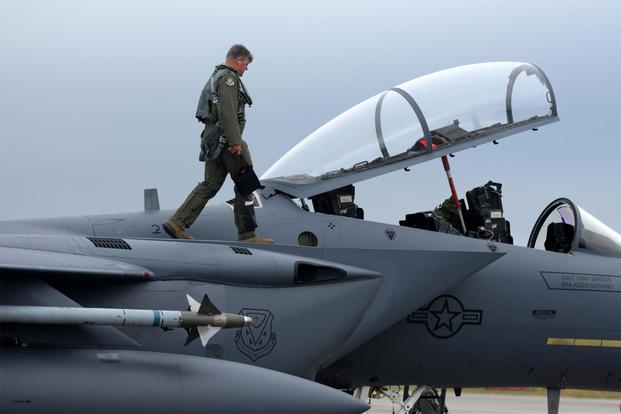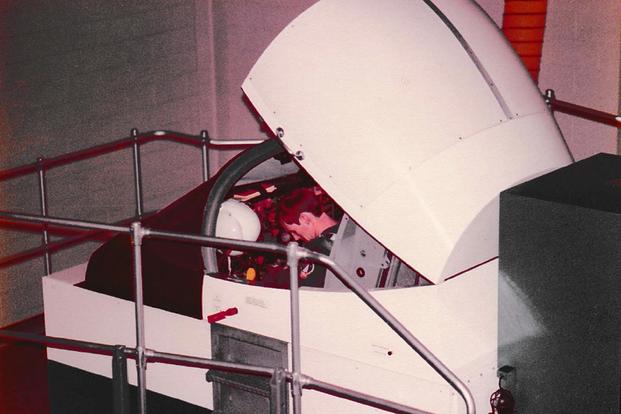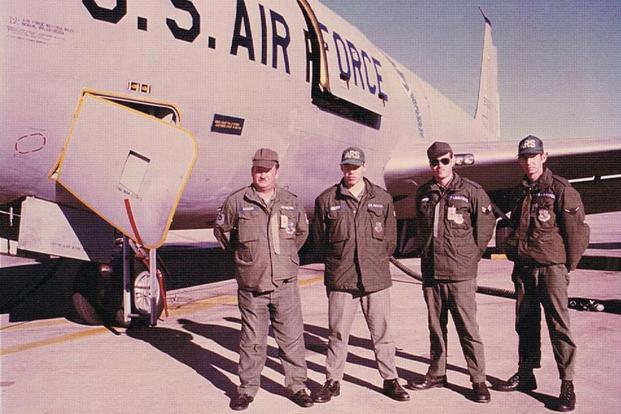Eugene Taylor remembers how eager enlisted airmen like him were to fly.
Taylor, who enlisted in 1968 and deployed to Vietnam, first worked as an avionics technician. Nearly a decade later, Taylor, a tech sergeant, became a T-37 and T-38 flight simulator instructor with the 71st Flying Training Wing at Vance Air Force Base, Oklahoma. He became so adept that he was occasionally given the chance to fly the T-38, with permission from the pilot, during stateside flights.
It has been decades since enlisted airmen had the chance to sit in the cockpit. But as the Air Force faces the greatest pilot shortages since its inception, service leaders are contemplating a return to a model that includes enlisted pilots. A Rand Corp. study, set to be completed this month, is exploring the feasibility of bringing back a warrant officer corps for that purpose. And another, separate Air Force study is examining, in part, whether enlisted pilots could benefit from new high-tech training that leverages artificial intelligence and simulation.
With these moves, the Air Force is inching just a few steps closer to someday getting enlisted airmen back in the cockpit, on a formal basis, for the first time since World War II.
“We have enlisted airmen in our Guard and reserve component who have private pilot’s licenses and fly for the airlines. So it’s not a matter of can they do it, or hav[ing] the smarts or the capability, it’s just a matter of us, as an Air Force, deciding that that’s a route that we want to take,” said Chief Master Sgt. Kaleth O. Wright, the 18th Chief Master Sergeant of the Air Force.
Military.com sat down with the service’s top enlisted leader last month to talk about enlisted aviators and reinstituting the warrant officer program.
“It’s something we walked away from years ago, and I won’t say that we haven’t been willing to relook at [it],” Wright said, of having enlisted pilots. “It’s nothing that we can’t overcome.”
Creating a Cadre
Wright noted there may be a few bumps in the road before an enlisted cadre could be instituted.
The main challenge would be to structure an appropriate career development path for the airmen, answering questions regarding when and how they would promote and when they would rotate to a new squadron. Wright said thus far officers “naturally float” to a flight commander or squadron commander from base to base, according to a system that has been in place for decades, but questioned whether the same system would work for enlisted pilots.
Additionally, the service would have to study whether enlisted airmen should be granted the right to employ weapons from an aircraft.
“Whether it’s manned or unmanned, if there’s an enlisted airman that’s going to be flying and employing weapons, it requires certain authorities we would have to get by,” Wright said.
For example, enlisted airmen are currently only authorized to be remotely piloted aircraft pilots on the RQ-4 Global Hawk drone, a surveillance-only platform.
Related content:
- Sound Off: Should the Air Force Allow Enlisted Pilots?
- Air Force Pilot Shortage Climbs to 2K Pilots, General Says
- If You're a Retired Pilot, the Air Force Wants You Back
“That’s just part of our age-old doctrine, that the employment of weapons, that the authority and responsibility lies with officers,” he said.
Reinstituting the warrant officer program could also help leaders decide on acceptable policies that would “determine if it makes us a more lethal and ready fighting force,” Wright said.
“What this is about is not just aviation or flying -- it’s about maintaining the technical expertise,” Wright said. “In some cases, having warrant officers will allow us retain that talent and keep those folks doing what they love.”
The Air Force in the past has commissioned studies to look into bringing back warrant officers, with another study from RAND, a nonprofit institution that provides research and analysis studies on public policy, on the way.
“The Air Force is partnering with RAND for a study on the feasibility of warrant officers and we are projecting a completion by the end of March,” Air Force spokeswoman Capt. Kathleen Atanasoff told Military.com last month.
Last month, the Air Force began a separate study on whether it could benefit from someday allowing enlisted pilots.
Air Education and Training Command said the study, called the pilot training next initiative, explores how pilots can learn and train faster "by using existing and emerging technologies that can decrease the time and cost of training," but with the same depth of understanding to produce quality pilots.
That includes using virtual reality simulation and A.I. to get airmen in an aircraft faster, with the potential of expanding the streamlined training.
The study is expected to conclude in August, in hopes of advancing all 20 students in the program: 15 officers and five enlisted airmen.
Foundation of Skills
Taylor, the Vietnam-era airman, served in the 341X1 career field for T-37 and T-38 trainers, which would quickly disappear once the Air Force reasoned enlisted personnel were needed elsewhere.
Once airmen were taught scenarios in a classroom, they would go to him to practice the maneuvers in the simulator.
“I was one of those people as an enlisted instructor, and it was the best job I ever had,” Taylor said in a recent interview with Military.com.
Through months of simulation tech school paired with his past experience working on planes, Taylor had gained the skills he needed to know the aircraft. Taylor’s instructor career field, however, dissolved only a year later, and he moved back into avionics at Columbus Air Force Base, Mississippi. But he remembers his “flight time” and experience with the T-37 and T-38 fondly.
“As a master avionics superintendent, I did get to fly in the back seat of the [T-38] aircraft six times to perform aircraft maintenance at off-station sites,” he said. “I told the pilot that I was a flight simulator instructor pilot at Vance. And when I flew, the pilot would say, ‘You know how to fly this, you do it.’ So, I would,” Taylor said.
Taylor recalled flying the aircraft from Columbus to MacDill Air Force Base,Florida.
“I [then] repaired another T-38 from our base and flew the aircraft back to Columbus. The pilot made the takeoff and landing on both legs of the flight, but I did all radio calls, and navigation,” he said.
Taylor would fly similar routes twice more with the same pilot.
“So yes, enlisted people can definitely perform the job,” he said.
According to a 1992 paper for the Air Force Enlisted Heritage Research Institute, the 341X1 and 341X2 career fields, born out of very early service ideals that enlisted members should work side-by-side with officer pilots, were Analog and Digital Trainer Specialists. The fields were part of the larger Aircrew Training Devices 34XXX specialty.
“The contributions of the enlisted men and women in the training devices career field were great,” noted the paper, written by Air Force student Senior Master Sgt. G. A. Werhs of the Senior Noncomissioned Officer Academy. “From its very beginning in 1939 until its end in the late 80s, [the 34XXX] was [an] entirely enlisted career field. All maintenance and operations were performed by highly skilled personnel. Every aircraft in the Air Force inventory had a simulator associated with it and enlisted members were there to operate and maintain it.
“[H]ow many people realize that for nearly 50 years those pilots received much of the initial training on the ground from enlisted soldiers and airmen[?]” Werhs asked.
Taylor suggested the career field closed because the service didn’t want enlisted troops to get to that next level: flying among officers. The service, he said, also had an abundance of pilots at the time.
“The Vietnam War had wound down, so they had more pilots than the Air Force needed,” Taylor said. “By taking away the enlisted instructors, it let them use the pilots that were qualified to fly the T-38 instead of kicking them out of the service.”
But there are many who believe that enlisted airmen, in some capacity, deserve the chance to once again get up in the air.
Rooted in History
Before the Air Force became a breakout service independent of the Army, enlisted pilots were known as "flying sergeants," receiving a promotion to staff sergeant once they completed pilot training.
Enlisted pilots, in one form or another, date back to 1912. But it wasn’t until 1941, when Congress passed the the Air Corps Act of 1926 and Public Law 99, that enlisted troops were able to receive qualified training.
“We never thought about whether we wanted to be an enlisted pilot or an officer pilot,” said retired Air Force Brig. Gen. Edward Wenglar, a former enlisted pilot. “We just wanted to be pilots, and we would gladly have stayed privates forever just to have the chance to fly,” Wenglar said in a 2003 service release.
Wenglar, who served overseas during World War II, holds the distinction of “achieving the highest rank of any former enlisted pilot,” according to the Air Force. He died in 2011.
During World War II, whoever was in the cockpit got grandfathered in and could remain flying. But in 1942, the passage of the Flight Officer Act meant new enlisted recruits no longer got the chance to fly.
The act, Public Law 658, replaced the program's sergeant pilot rank with the warrant officer rank.
When the Air Force was created in 1947 out of the Army Air Forces, it would bring more than 1,000 legacy warrant officers in. The service stopped the program in 1959, the same year it created the senior and chief master sergeant ranks. The last warrant officer would retire from active duty in 1980.
With more than 3,000 enlisted sergeant pilots throughout the service’s history, 11 of them would become generals and 17 would become flying aces, according to information from the Air Force. More than 150 enlisted pilots would be killed in action.
“Our careers as enlisted pilots made us better men and gave us opportunities later in the civilian world that we never would have been offered," Wenglar said in 2003.
New Focus on Warrant Officers
“If the Air Force is so very concerned about the pilot shortage, they should consider warrant officers in … the transport pilot, flight engineer, boom operator and drone pilot fields,” said Will Stafford, a former staff sergeant with similar maintenance, tech and simulator experiences as Taylor.
While in the Air Force in the 1970s and 80s, Stafford, outside of his military duties, would fly smaller aircraft such as Cessna 310s, Beechcraft Model 18s and some Douglas DC-3s. On his own, he would eventually become qualified “on 25 different makes and models of fixed-wing aircraft,” he told Military.com.
“If the [Air Force] wants their veteran airmen and airwomen to return, then they had better look at how it has squandered the talent, training and dedication that many of us had, and make some serious changes, beginning with the restart of the warrant officer corps,” Stafford said, referencing the Air Force’s initiative to bring back retirees into staff-rated positions to balance out the ongoing pilot shortage.
“This is cost-effective, and many professional fully-rated civilian pilots who have military experience would have no problem,” he said.
Stafford has tried, unsuccessfully, to start a White House petition on Whitehouse.org to get the administration’s attention about reinstituting the warrant officer corps. He has even tried to petition the Air Force directly by writing to then-Air Force Chief of Staff Gen. Norton A. Schwartz, who Stafford got the chance to meet and work with when Schwartz was just a captain.
Schwartz told Stafford it just wasn’t in the Air Force’s plans.
Key Decisions Ahead
Wright says the new RAND study may give him and Chief of Staff of the Air Force Gen. David Goldfein fresh perspectives.
“We have to be smart about this, right?” Wright said. “This can’t just be, ‘Oh, this is nice to have.’ We have to know exactly what we’re buying [into] and we have a plan to implement it.”
Wright said cost-benefit analysis would play into the decision.
“I’m looking to learn, and the boss [Goldfein] is looking to learn, again, that simple question: Will this make us a more lethal force? Will it make us more efficient?” Wright said.
“There is a chance through the RAND study and through some of our internal studies that the evidence reveals and the analysis reveals that warrant officers won’t move the needle that much,” he said.
While Wright said it’s hard to say when enlisted pilots or a warrant officer program may come back into the Air Force’s ranks, he believes the feat can be achieved in roughly five to 10 years.
“I think it would help would shortages in career fields, I think it would help with retention, I think it would help with career development.
“Now there’s nothing that says that, within our current system we can’t do that same thing. But if you’re asking me what the obvious benefits are,” he said, “ … I think it’s a good thing.”
Oriana Pawlyk can be reached at oriana.pawlyk@military.com. Follow her on Twitter at @oriana0214.














